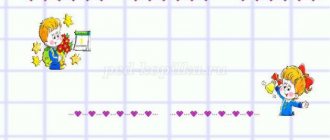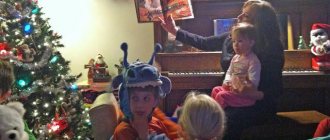Lesson attendance certificate
Reference
based on the results of visiting lessons of primary school teachers
20__/20___academic year.
In accordance with the in-school control plan, visits to the lessons of primary school teachers were carried out.
Target:
1) implementation of uniform pedagogical requirements for the educational process;
2) compliance with the requirements of the Federal State Educational Standard.
Test methods:
observation, familiarization with classroom documentation, visiting lessons, interviews with teachers.
Analysis of work programs and lesson planning showed that these documents are compiled by teachers in accordance with the requirements.
During the inspection, it was found that teachers working in primary classes conduct lessons in accordance with the requirements of the Federal State Educational Standard, use a variety of techniques and methods to enhance the cognitive activity of students. Favorable conditions have been created in the classrooms for the normal development of children; teachers use every opportunity for students to successfully master program material and to form universal educational actions in students.
The requirements for students by teachers are uniform and correspond to the educational program of the school.
Each lesson begins with the organization of the class (checking the availability of writing materials, textbook, notebook, etc.).
During lessons, physical exercises lasting 1-2 minutes in a playful or musical form are mandatory. The classrooms are ventilated according to schedule, during breaks, without the presence of children.
It should be noted the friendliness of the teachers and mutual understanding with students. Lessons proceed at a good pace.
Teachers' lesson plans correctly reflect the content of the educational material. The lessons use colorful visual aids and handouts, interactive and multimedia equipment (computer presentations, interactive whiteboards).
In Russian language and literacy lessons, teachers take an individual approach to students; in accordance with the different levels of preparation and knowledge of students, different forms of teaching are used, and visualization is used to a large extent. A differentiated approach is used for low-performing students (cards with tasks, simplified tasks, replacing written answers with oral ones (if necessary).
Teachers plan mathematics lessons competently, taking into account a differentiated approach to teaching. Children clearly comply with teachers’ requirements and participate in mathematical games with pleasure.
The following lessons were attended: 1B grade (learning to read and write, learning to write); 1B grade (literacy, writing, mathematics), 2B grade (music), 3A (English), 3B (physical education), 4a (mathematics).
Results of visiting lessons.
Music lesson _____
took place in the traditional manner. The lesson includes educational and gaming activities. The children listened to music, sang in chorus, and learned classical music by ear. The teacher’s speech, demeanor, and professional skills serve as a positive example to follow. But it should be noted that the teacher does not use ICT in the lesson; the content of the lesson only partially complied with the requirements of the Federal State Educational Standard and the educational program of the school.
_______
, the young specialist constructs his lessons quite competently. She carefully selects tasks and analyzes them from the point of view of a practical focus on the formation of UUD in the lesson. In her practice, she quickly corrects comments on the lesson design, and builds subsequent lessons taking into account the methodological recommendations given to her. Clearly defines the topics and goals of lessons. Uses ICT correctly. The lesson includes activities in pairs, groups, and reading in chorus. The teacher organizes the work in such a way that students draw their own conclusions and correct their mistakes.
At the teacher's _______
The following stages of the lesson turned out well: motivation to gain new knowledge, updating of learned knowledge (cognitive UUD). Lessons are conducted at an optimal pace, the lesson structure is maintained, and goals are set and achieved. A variety of educational activities ensures the stability of the educational and cognitive atmosphere. The teacher’s speech is clear, accessible, and conclusions are drawn in a timely manner. Individual control encourages people to express their opinions. When reading syllables and words, the teacher achieves clarity in pronunciation and reading, explaining the lexical meaning of difficult words.
______
conducted a lesson with close use of ICT and its capabilities. The lesson showed that the teacher masters the methods of teaching English at a high level and has professional competence. The lesson was distinguished by its high density, accessibility of presentation of the material, efficiency of methods and techniques, expediency of time allocation, logical sequence and interconnection of stages. The students showed activity in the lesson conducted using ICT tools. They demonstrated mastery of communication skills and used information from Internet resources. Working with the interactive whiteboard aroused keen interest among students.
However, when developing lessons using ICT, special attention must be paid to children's health. Be sure to include physical and dynamic breaks and eye exercises.
The physical education lesson was prepared qualitatively _______.
The children showed good preparation for their age. During the lesson, activity was high thanks to the teacher’s ability to attract and maintain students’ attention using technical means and a well-thought-out series of physical exercises. The teacher demonstrates to the children how to perform each exercise and gives instructions clearly and clearly. At the beginning of the lesson, a safety briefing was given.
Teacher ___
carefully considers tasks for students to develop mathematical and logical skills. Students worked with a textbook, with individual cards, choosing the most comfortable level of tasks for themselves. The dialogue between the teacher and students is friendly, calm, clear and understandable. The atmosphere in the class is working. Interdisciplinary and feedback connections are constantly monitored; the teacher creates a problem, the solution of which involves students.
Recommendations:
Primary school teachers should continue teaching children in accordance with the requirements of the Federal State Educational Standard, using various pedagogical technologies, using various techniques and methods to enhance the cognitive activity of students.
Use office equipment rationally.
Plan and organize work in the lesson with children with disabilities.
Attend each other's lessons more often in order to exchange experiences.
Deputy Director for HR —————
Consultation “Open classes as an effective form of methodological work”
Open lesson is one of the effective forms
organization of methodological work in preschool educational institutions
Increasing the level of skill of teachers is a priority area of methodological work, which occupies a special place in the management system of a preschool institution and represents an important link in the holistic system of advanced training of teaching staff. A constant connection between the content of methodological work and the results of teachers’ work ensures a continuous process of improving the professional skills of each educator.
Therefore, preschool educational institutions use new, effective forms of work that contribute to the activation of the teacher’s personality and the development of his creative personality.
Open classes are one of the effective forms of organizing methodological work in preschool educational institutions.
In educational practice, sometimes they do not distinguish between open and regular classes, and do not represent the features of preparing and conducting open classes.
An open lesson, unlike ordinary ones, is a specially prepared form of organizing methodological work, during which the main directions of the educational process of a preschool institution are implemented.
In an open lesson, the teacher shows his colleagues his positive or innovative experience in implementing a methodological idea, using a specific method or teaching method.
In this sense, an open lesson has a methodological goal, which contains the main points of what the teacher can show to those attending this lesson.
The purposes of open viewings are varied. Before the start of the lesson, the teacher first introduces the teachers to the lesson.
| I | Group characteristics: | - age characteristics of children; -the degree of children’s assimilation of the program; - real educational opportunities for children. |
| II | A story about the project for the upcoming lesson: | -place of the lesson in the topic, section, etc.; -goals, objectives of the lesson; -characteristics of educational content -material; -lesson structure. |
| III | Justification for the open lesson project | -relevance of the chosen topic of the lesson; - connection between the topic of the lesson and the methodological a problem, a topic of self-education that the teacher is working on. |
| IV | Open lesson plan | 1. The topic of the lesson and the “name” of the lesson. 2. Formulated methodological innovations proposed in the upcoming lesson. 3. Brief structural summary of the most interesting element of the lesson: supporting summary; samples of didactic materials (didactic games, handouts, sample, etc.); memos, booklets; list of used literature. |
There are a number of requirements for preparing and conducting open classes with preschool children.
1. Open classes are conducted by teachers who have a high level of scientific and methodological training and ensure high efficiency of the educational process;
2. An open lesson is a source of innovative experience and includes current problems of methodological science in the field of preschool pedagogy and psychology;
3. Open classes must be novel;
Novelty may relate to the content of didactic material or methods of studying it.
Showing classes in which methods that are widely used in practice are implemented does not contribute to the professional growth of other teachers.
In methodological work with young teachers, this limitation does not always need to be taken into account, since for them traditional, well-known methods are of a certain interest.
4. An open lesson as a form of organizing the educational process may itself contain a new, special structure;
5. An open lesson reflects the solution to a methodological problem, a topic of self-education, on which the teacher is working;
Its individual methodological theme is associated with the general methodological problem of the preschool educational institution team; it is this indicator within the framework of the lesson that contributes to the implementation of a systematic approach to the organization of scientific and methodological work in the teaching staff;
6. An open lesson shows (proves) the advantages or high efficiency of innovation or tradition in organizing children’s activities, therefore the teacher showing the open lesson chooses a topic whose content allows this to be done;
7. The teacher selects the topic of an open lesson in advance and prepares theoretical material, visuals, multimedia, classroom space, equipment, etc.;
8. When conducting an open lesson, all requirements for the educational process are met, the lesson is conducted under normal conditions, with a generally accepted duration, etc.;
9. An open lesson should not harm the system of knowledge, abilities and skills of children, their values.
Children should gain as much knowledge as they would have learned by studying this topic without anyone attending; it is also unacceptable to explain only that part of the lesson topic that allows you to most clearly demonstrate a new methodological technique, leaving the next part for another lesson or other activity.
10. A workplace must be prepared for visitors, which is located behind the children’s backs so that visitors do not distract their attention;
The visitor cannot be seated next to the child, on the side. The number of visitors to an open lesson cannot be unlimited. For example, in a group of 20 children invited to an open lesson, there are 10-15 teachers. Observations show that the attendance of classes by at least one stranger creates discomfort for both the teacher and the children, and therefore, it is now widely practiced to study the experience of teachers using video recordings of their professional activities.
11. Open classes and their content should not contradict the programs under which the teacher and the preschool educational institution as a whole work.
12. It is unacceptable to “rehearse” an open lesson with the same group or subgroup of children;
The day before, it is recommended to inform children and parents about an open lesson; this will prepare children for the situation when there will be visitors to the lesson;
13. Open viewings of classes and other activities are carried out in accordance with the methodological work plan of the preschool educational institution and teachers must have sufficient time to prepare it;
Practice shows that it is impossible to conduct several open classes in one group on the same day; it is also undesirable to conduct such classes in the same group within a month. This is explained by the great psychological stress that children and teachers experience.
14. When preparing an open lesson, the triune didactic goal must be taken into account: teaching, educating, developing and, additionally, motivational;
When preparing an open lesson, the teacher must take into account three types of motivation:
-social – creating a situation of success, using praise, encouragement, the child’s right to make mistakes;
-substantive – the formation of experience in collective and creative activity, the organization of individual work with children, the creation of a problem situation;
-pragmatic – to increase children’s attention to this type of activity, the development of cognitive interest in preparing the future student (FEMP, speech development, children’s experimentation, artistic activities, etc.).
15. To actualize children’s cognitive interest during an open lesson, a teacher can use a variety of methodological techniques:
- clear organization and planning of all parts of the lesson;
-intriguing beginning;
- taking into account the individual characteristics of children;
- friendly tone, gestures, facial expressions that are attractive to you;
- motives for activity.
Analysis of an open lesson with the participation of those who attended the lesson is not mandatory. If the methodological work plan of the preschool educational institution plans to analyze it, then first the floor is given to the teacher - the author of the lesson. It recalls the methodological goal of the lesson and gives a brief description of the work to achieve it. In contrast to the analysis of classes attended for the purpose of control, a discussion of open viewing involves consulting those present, reflection, active discussion, exchange of opinions, discussions, disputes, etc. .
Notes of all open classes are prepared and stored in the methodological office.
When preparing for an open lesson, a teacher needs to predict the expected results and expected risks.
Methodologically competent organization of open screenings of children's activities, including open classes, contributes to the continuous improvement of teacher qualifications in preschool educational institutions, comprehension of advanced pedagogical experience at a higher theoretical and practical level, and improves professional skills.



